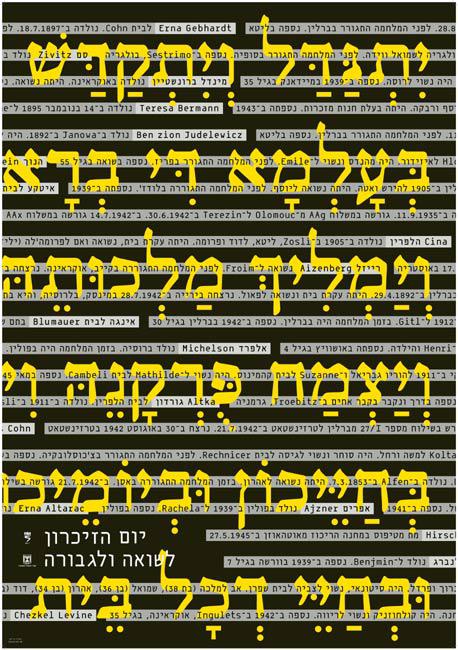The poster is comprised of three interconnected layers. The first, and most prominent layer is a section of the Kaddish prayer. The second layer conveys historical details that pertain to the family of the designer of the poster. The final layer is the artistic detail of the poster, the manner in which the Kaddish is cut and colored yellow and how family details are presented as grey lines, themselves also cut.
Every society has its own ways to remember and deal with mourning. In Judaism there are a number of different ceremonies and practices that provide ways to remember those who have passed, as well as methods to deal with loss that focus on continuity and living. One of the most significant elements of memory and dealing with loss that we have as a collective is the Kaddish prayer. The prayer leader recites the Kaddish a number of times during a regular prayer service, but there are also assigned times during the service when mourners recite the Kaddish. This is known as "The Mourner's Kaddish" – a version that is said by immediate family members of the departed to honor their memory. The Kaddish is said during the three daily prayers (Shacharit [Morning], Mincha [Afternoon] and Arvit [Evening]) as well as at the conclusion of Torah study that is undertaken in memory of the departed during the extended mourning period . After the first year, the date of passing is set as a memorial day known as "yartzeit" (literally "time of year") Every year on the yartzeit of the departed, Kaddish is recited by the immediate family members at the three daily services. The Kaddish is in Aramaic as it that was the common language used by Jews at the time it was composed.
It is important to point out that during the Shoah most of the victims were forced to deal with mourning without the familiar tools and practices they could usually rely on. Private burial and erecting tombstones were rare, and practices such as "sitting shiva" were particularly difficult in the ghettos and impossible in the camps. This inability to observe the traditional practices was a significant obstacle for many in their ability to deal with the losses they were suffering. The mourning traditions provide a framework for parting from someone dear. Since these were not available to most Jews during the Shoah, they were left with the pain of loss without any means of process or closure.
The personal details that appear on the poster are dates and two types of names: names of people and names of places in Europe. The people are members of the poster designer's family who perished in the Shoah. You'll notice that the names reflect the types of people that comprise the Jewish people: Yiddish names, Hebrew names and foreign (secular) names.
The other names are names of countries, cities and murder sites throughout WWII Europe. Just like the lines of the Kaddish, the lines of the names are cut off. They are also written over the top of the lines of Kaddish.
The combination of the Kaddish and the personal information about the designer's family teaches us about the necessary connection between private memory and collective memory. Without the information about the family members that were murdered in the Shoah there cannot be a collective memorialization. The fact that the elements in the two layers are cut off is testimony to the dehumanization endured by victims of the Shoah. The cuts in the poster hide within them the shouts of the victims on the one hand, and our inability to know every details of the events that took place during the Shoah on the other. The artistic decision to present the information in grey lines reminds us of the striped uniforms of the camp inmates during the Shoah. (The lines also remind us of the train tracks.) Seeing the lines as the uniform transforms the poster into the body of a Jewish prisoner for whom Kaddish is said ; A Jewish prisoner represents a specific person (one of the family members of the designer of the poster) and at the same time an anonymous Jewish prisoner, for whom it is difficult to say Kaddish given that we don't have information about him.







